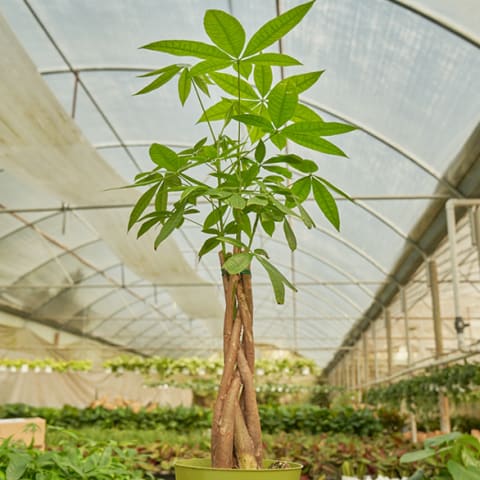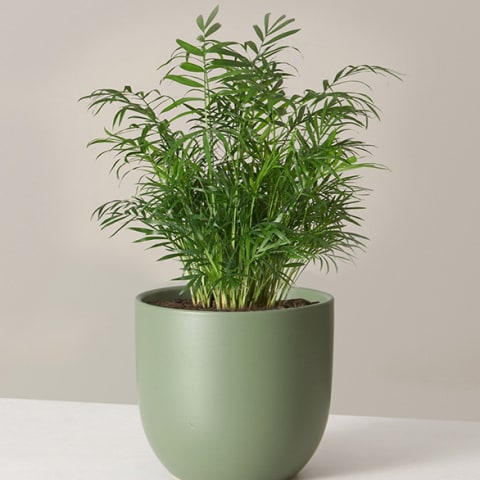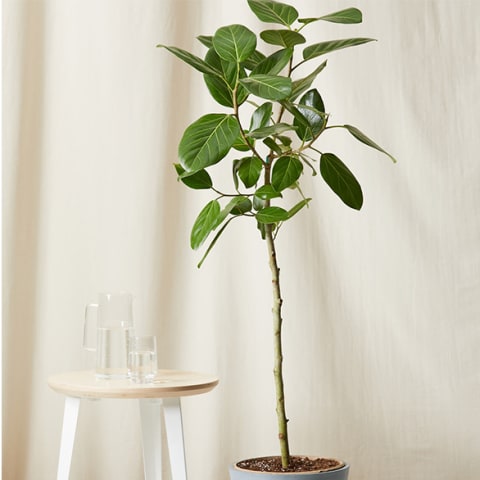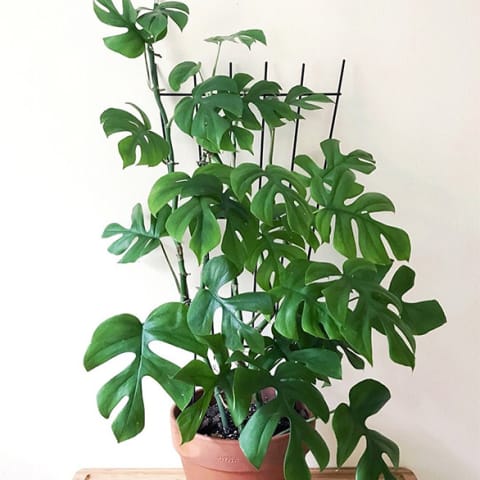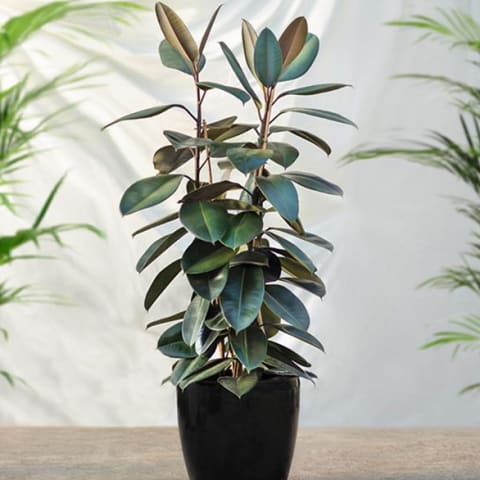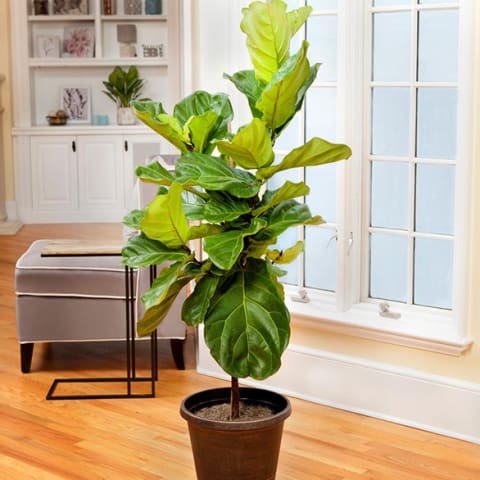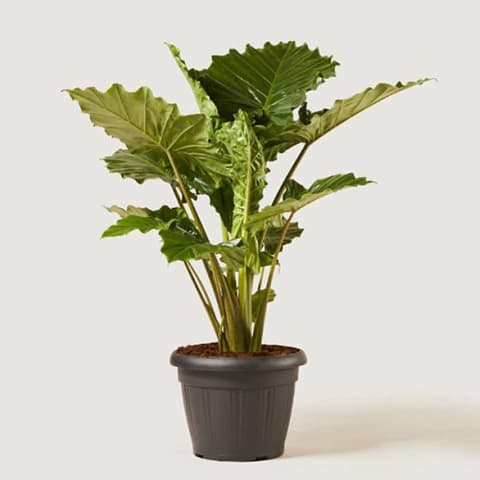Some larger plants and trees can be quite finicky, so we split up the list based on how difficult each one is to take care of and what it needs to thrive. Whether you’re a new plant parent or a vegetation veteran, consider this your cheat sheet to the giant greenery of your dreams. Price: $60–80 for a mature plant What it needs to grow tall: Bright & indirect light, clean leaves, a snug pot A tropical tree with a unique braided stem, the Money Tree got its name from ancient Chinese folklore, where it was the answer to a poor farmer’s prayers for wealth and success. Today, it’s still considered a great plant for attracting abundance at home in feng shui. Give it bright, indirect light, water it every one to two weeks, be sure to clean off its leaves every so often, and your Money Tree should thrive. Pro tip: Since Money Trees have small root systems, they don’t need a ton of room and will grow better in smaller pots. Price: $30–100 for a mature plant What it needs to grow tall: Time between waterings There are many varieties of snake plant—all of which share the plant’s signature wide, fleshy leaves. Most snake plants are incredibly low-maintenance, and while they can be slow to grow, some varieties, like the Sansevieria laurentii, can eventually reach 6 feet tall. Since they’re technically succulents that hail from the desert, snake plants know to store extra moisture in their leaves. This means that they can last a few weeks between waterings and shouldn’t be watered too often (or misted ever). Price: $50–200 for a mature plant What it needs to grow tall: Moist soil, proactive pest protection Rich in thin, dense leaves, the bamboo palm adds a tropical touch to any room. These palms are native to the forest understory of Mexico and Central America, so they appreciate less intense lighting and lots of moisture. (This is one plant you don’t want to stick in front of a window that gets lots of direct sun.) Bamboo palms tend to be super easy to care for, but they are prone to pests. Watch out for mealybugs and spider mites on their leaves, and treat any infested areas with neem oil. Price: $40–90 for a mature plant What it needs to grow tall: Bright & indirect light, dry soil between waterings Another low-maintenance palm with similar foliage to its Bamboo cousin, the Parlor Palm has a long history of being grown indoors (hence the name!). It appreciates bright, indirect light (read up on what that looks like at home here) and a light hand when it comes to watering. Brush up on the best watering strategies before giving this lush tree a drink. Price: $70–300 for a mature plant What it needs to grow tall: Bright & indirect light, dry soil between waterings Often referred to as the less finicky relative of the Fiddle Leaf Fig, the Ficus Audrey delivers just as much drama as its trendy cousin. It’s a vigorous grower in its native climate of India and Pakistan—and in the wild, this fig is known to strangle other trees. You can nurse this tall houseplant to life by recreating the warm, humid conditions it comes from. Give it bright, indirect light, make sure its soil dries out between waterings, and mist its leaves every so often or place it near a humidifier. Price: $20–80 What it needs to grow tall: Bright, indirect light, regular fertilizing While not technically a Monstera plant, this lush looker has similarly shaped leaves in a vibrant green hue. It can thrive in bright, indirect light and will really get growing with occasional fertilizing. Don’t let the name fool you: While this plant doesn’t naturally grow upward, it’s a fast and furious climber. Secure a stake or trellis behind it, and you can train it to climb up your walls for an overgrown jungle look. Price: $50–70 for a mature plant What it needs to grow tall: Bright light, occasional fertilizing The Rubber Plant’s sap was used to make rubber in the 1900s, but these days it’s mostly prized for its unique waxy, dark green leaves. Native to Southeast Asia, this is a plant that appreciates a lot of sunlight. It’ll grow the fastest in a bright window, ideally one that faces south or west. Be sure to move your plant into a bigger pot every one to two years to make room for all that new growth, and fertilize occasionally to give it the proper fuel. Price: $50–200 for a mature plant What it needs to grow tall: Bright light, dry soil between waterings, clean leaves One of the most popular tall houseplants out there, the Bird of Paradise boasts large, striking leaves and doesn’t require too much work on your end. Give it a few hours of direct sun a day, water every one to two weeks during the growing season, wipe down its dust-attracting foliage occasionally, and it’ll reward you by growing upward, outward, and every direction in between. Price: $30–90 for a mature plant What it needs to grow tall: Bright & indirect light, humidity Unlike most tall floor plants, the Majesty Palm is pet-friendly according to the ASPCA, so cat or dog owners can display this tropical variety at home without worry. Though slow to grow, it’s pretty easy to care for and just needs bright, indirect light and some extra humidity once and a while to stay happy. Price: $60–200 for a mature plant What it needs to grow tall: Bright sun, consistent watering, a stable environment (no drafts) Though it definitely falls more into the finicky category, Fiddle Leaf Figs are still incredibly popular. If you want to bring their signature fan-shaped leaves into your space, you’ll need plenty of sun, zero drafts, and some watering know-how. Fiddle Leaf Figs don’t appreciate shifting surroundings, so once you find a spot where it’s happy, keep it there! Price: $100–200 for a mature plant What it needs to grow tall: Bright & indirect sun, warmth, humidity Named for its massive heart-shaped leaves, Elephant’s Ears have a similar growth pattern to the Bird of Paradise—though they’re a little pickier. More common as an outdoor plant, they need bright but not direct sun, moist soil, and a warm, humid environment to survive indoors. Native to the tropics, this is one plant that would do well next to a humidifier and away from any drafty doors or open windows. Emma received her B.A. in Environmental Science & Policy with a specialty in environmental communications from Duke University. In addition to penning over 1,000 mbg articles on topics from the water crisis in California to the rise of urban beekeeping, her work has appeared on Grist, Bloomberg News, Bustle, and Forbes. She’s spoken about the intersection of self-care and sustainability on podcasts and live events alongside environmental thought leaders like Marci Zaroff, Gay Browne, and Summer Rayne Oakes.


